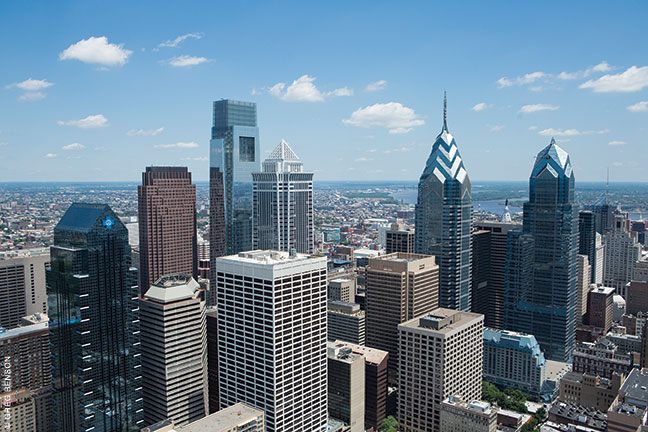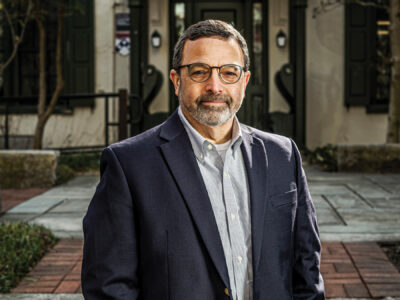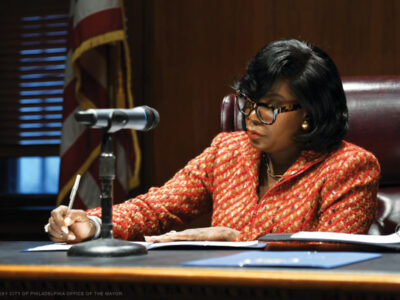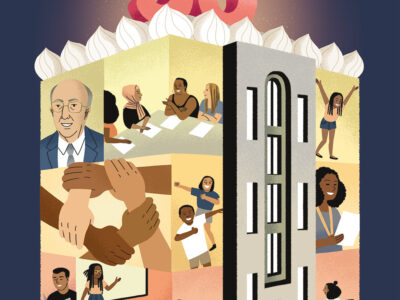
Philadelphia is, famously, a city of firsts: first library, first zoo, first university, first fire department, and so on. Some of those innovations weren’t even associated with Benjamin Franklin (well, just the zoo, really, which was founded in 1874), but his adopted hometown’s latest distinction would certainly have pleased Penn’s well-traveled founder.
Following an intensive and determined campaign by area business, political, and academic leaders, including Penn faculty, last November Philadelphia became the first US city to be designated a World Heritage City. Denis Ricard, secretary general of the Organization of World Heritage Cities, which awards the designation, says of the effort, “I’m impressed by this Philadelphia. They are positively aggressive!”
The award puts Philadelphia in the company of places like Paris, Jerusalem, Rome, and Delhi—cultural and historical capitals deemed to have “outstanding universal value”—or OUV, as insiders call it. “It’s not enough that [a city] be important,” explains John F. Smith III, board chair of the Global Philadelphia Association, which led the application effort. “It’s not enough that it be of great importance to a country. It has to be of great value to humanity. It’s a pretty high standard.”
World Heritage cities work together to exchange art exhibitions, international students, and foster business opportunities. They share best practices for tackling tricky issues like sustainability and preservation. The title can also boost tourism, as the collection of World Heritage Cities serves as a bucket-list for some travelers. The Global Philadelphia Association predicts international tourism growth of 10 to 15 percent, which would bring in an estimated $150 million in spending. In 2016, the travel guide Lonely Planet listed Philadelphia as its number one place to visit in the US, writing, “Freshly crowned as US’s first and only World Heritage City … Philly’s on a roll.”
The designation may also spark a welcome bout of cognitive dissonance for the city’s residents, who have more practice disparaging their hometown than celebrating it. “Philadelphians aren’t used to thinking they are that important,” says architectural historian David Brownlee, the Frances Shapiro-Weitzenhoffer Professor of 19th-century European Art, who helped write the membership submission. “But in every era of our history important things have happened here. In every district of the city, in every neighborhood of the city, important things have happened here.”
And Philadelphia’s success in winning the designation paves the way for other US cities to follow. “That helps position the United States more effectively in the world,” according to Richard Hodges, president of the American University of Rome, who was director of the Penn Museum of Archaeology and Anthropology from 2007 to 2012, during which time the effort was launched.
While working on archaeological projects at World Heritage sites in Albania and Greece, Hodges had seen the benefits of the designation and thought the image boost could also help Philadelphia recover from the Great Recession. “I got to know about World Heritage as an asset, as something that could help,” he says. “It would actually change the identity, the way people thought about Philadelphia, and the volume of income coming in.”
Although Hodges doesn’t explicitly remember doing so, Smith credits him with planting the idea for making Philadelphia’s case. Smith in turn got then Mayor Michael Nutter W’79 on board. In 2013 Alan Greenberger, then the city’s deputy mayor for economic development and director of commerce, put together a working group that included scholars like Brownlee.
Philadelphia gained observer status in the Organization of World Heritage Cities in 2013, with the goal of learning how to join. “No one had a clear notion of how to do it,” says Smith, since there was no US precedent. They quickly encountered an obstacle in the rules governing who could even be considered for the designation. To qualify for membership, cities had to have a UNESCO World Heritage-designated territory in their city. Philadelphia had Independence Hall, but that was only a single building—not a larger area like Society Hill or Fairmount Park, for example. Paris’s World Heritage site, by contrast, encompasses 900 acres of the Seine Riverbank.
Though the Organization of World Heritage Cities isn’t affiliated with UNESCO or the United Nations, it uses their designations to screen applicants. That put US cities at a disadvantage, because the process of getting UNESCO designations here—candidates must first get an award from the National Park Service, then convince the State Department to apply on their behalf—is harder than in most countries.
Rather than getting mired in that bureaucratic run-around, or giving up, Philadelphia lobbied the organization to change its bylaws. In 2014 the team submitted their case. “We made a claim from the beginning that although our membership depends on one building, we really used it to highlight the number of historical resources in Philadelphia,” says Brownlee.
Smith lobbied World Heritage officials in Budapest, Vienna, Havana, and other locations to support Philly’s inclusion, and Global Philadelphia persuaded Ricard to come visit the city personally. In November last year, Greenberger gave a presentation to the board of the Organization of World Heritage Cities at its annual meeting in Arequipa, Peru, and membership was formally granted.
Changing the bylaws also means that now any city, including many in America, with a UNESCO site can apply. There are currently 287 World Heritage cities, “but with this option now, worldwide we can go up to 636,” says Ricard. “In terms of growth, in terms of potential, it’s tremendous. And the spark was Philadelphia.”
Even before the official announcement last fall, Philadelphia’s team was exploring how to turn it to the city’s advantage. “It’s a present without an immediate and obvious use, but we have to figure out what it is,” says Brownlee. A group of 150 stakeholders was assembled, and divided up into eight working groups to explore topics like tourism, preservation, and education.
One of the largest efforts so far aims to educate Philadelphians about what it means to be a World Heritage city. “We are determined to make heritage an important and meaningful subject for everybody in Philadelphia,” says Smith.
So far they’ve created a website and a half-hour video to spread the word, Brownlee says.
Another working group is creating a web-integrated database that will allow people walking around Philadelphia to use their phones to learn the history of buildings and sites right in front of them.
Anastasia Shown SPP’07, a community outreach consultant with Penn’s South Asia and Middle East Centers, was instrumental in creating a program for teachers and a series of lesson plans about what world heritage means for Philadelphia that will be used in public and private schools across the city. Global Philadelphia honored her work with its annual award.
Other groups are looking at economic benefits less obvious than tourism. For example, the world-heritage city designation might be used to attract investment dollars to renovate historic buildings, possibly by strengthening the case for tax relief for owners of historic properties who make costly improvements within strict historical guidelines. “There are some tax breaks for businesses owners or developers whose buildings are on the National Register,” Brownlee notes, “but nothing for private home owners or for properties that are only on the Philadelphia Register.”
Most important, being a World Heritage City is a recognition of Philadelphia’s contributions to culture and history. “This is something that Philadelphia rightfully deserves, and it’s been frankly strange that we haven’t gotten this designation,” says Brownlee. “But it’s also true that Philadelphia has been slow to recognize its own greatness.”
–Alyson Krueger C’07





Thank you so much for sharing this with readers and alumni. What a distinction. I loved how you began the article. Yes, Philly is a city of firsts. Bravo, Philadelphia!
This is fantastic! What an honor for our City!